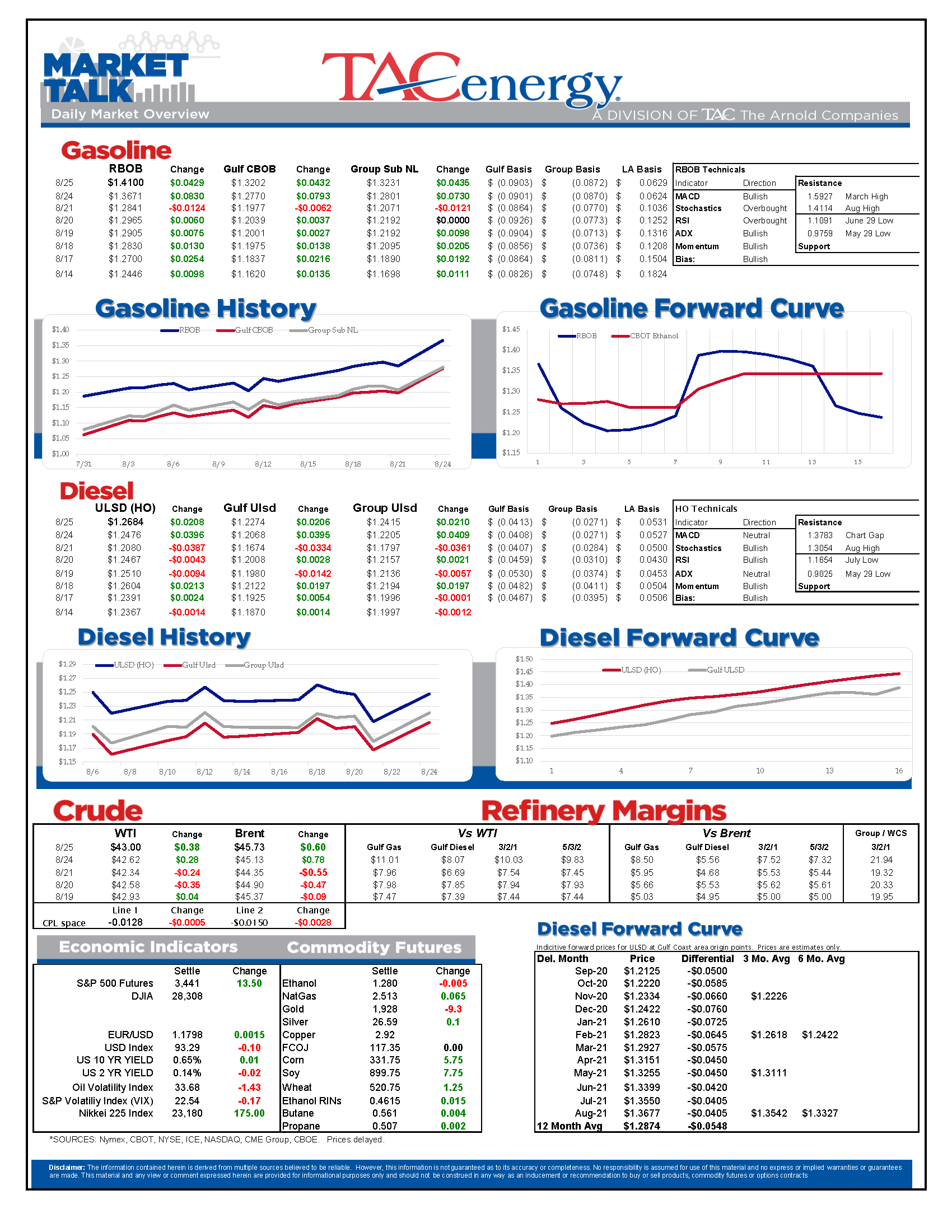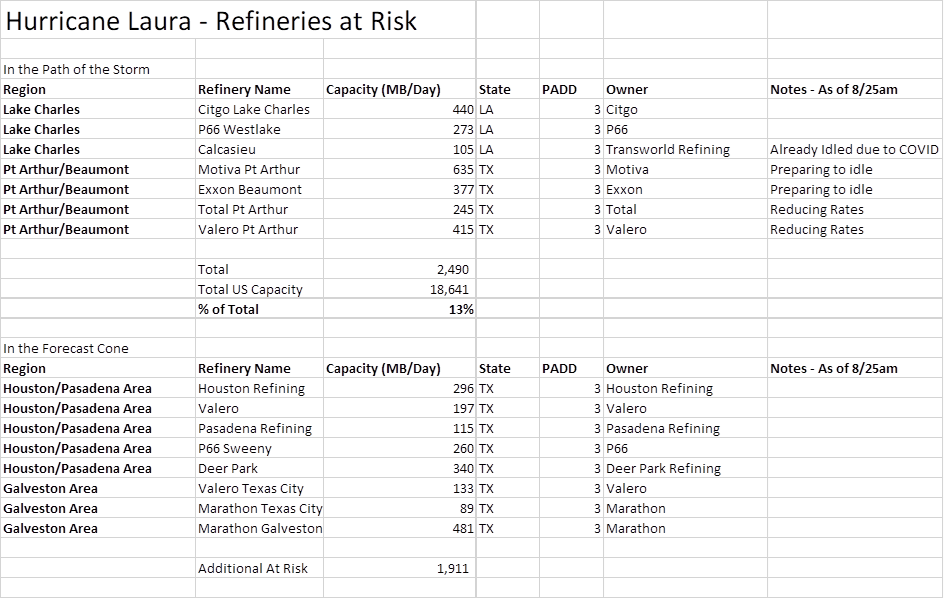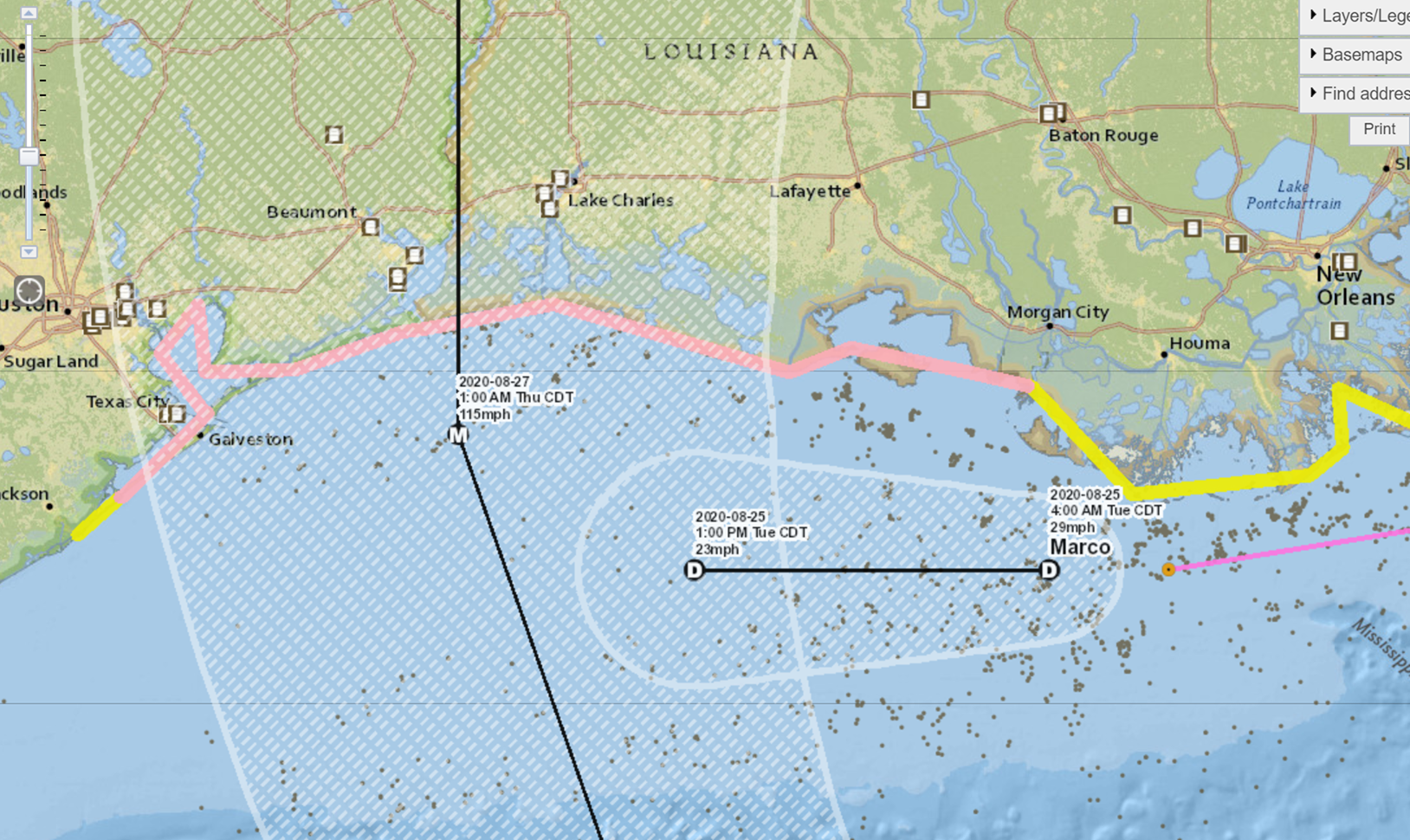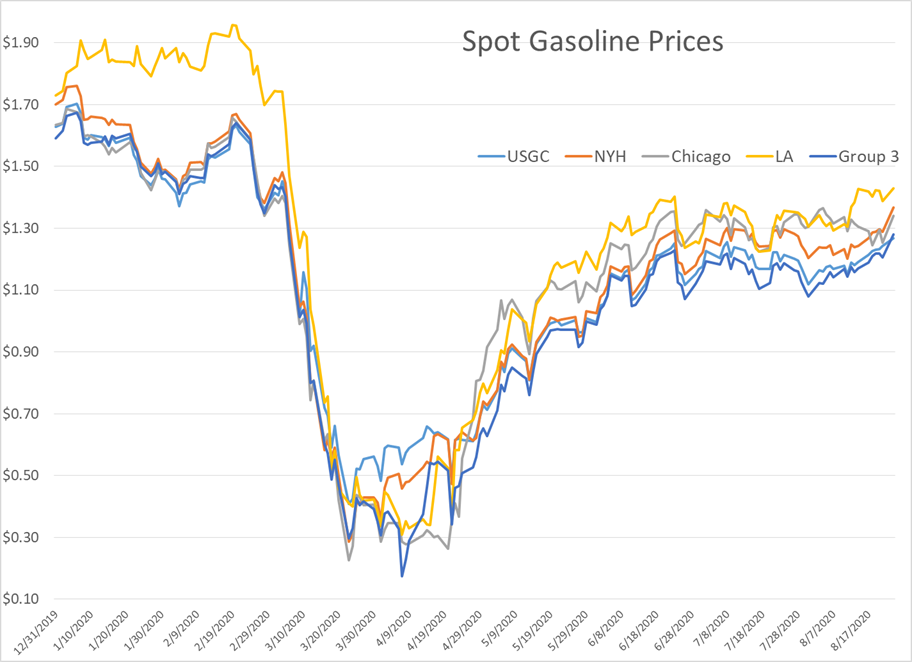Hurricane Laura Threatens U.S. Refineries

Gasoline prices are approaching six-month-highs as Hurricane Laura poses the biggest threat to U.S. refineries since Hurricane Harvey three years ago. Oil and diesel prices are moving higher as well, but are not keeping pace with gasoline – which is often the case in storm situations – and seem somewhat dubious about the long term impact this storm may have on an oversupplied market.
The Nasdaq and S&P 500 reached new record highs as trade and virus optimism kept the trend lines pointing higher, while the DJIA is undergoing a major overhaul. In the latest sign of the COVID market fallout, ExxonMobil is being removed from the DJIA, while Salesforce (dot com) will now be included.
While Marco fizzled out and spared Louisiana, Laura was upgraded to a Hurricane this morning, and 13 percent of the country’s refining capacity is in the direct path of the storm based on the latest models. The current forecasts have the storm coming on shore Thursday morning, as a category 3 “major” hurricane, just east of Port Arthur, TX. Plants in the Port Arthur/Beaumont hub have announced that they are reducing rates and/or idling units until the storm passes. The path of the storm could actually be just as troublesome, if not more, for plants around Lake Charles, LA, as they are on the more dangerous side of the storm, and could get a worse surge/flooding than the plants closer but on the west side. There is still a wide cone of uncertainty with this storm’s path, and even the Houston-area plants could still be impacted if the storm shifts further west.
Those plants that can continue operating are suddenly seeing their best margins in five months, a much needed relief for plants struggling to stay afloat financially. The economic hardship of refineries is one reason Laura’s impacts may not be as widespread as we might normally expect, since there’s at least one million barrels/day of capacity already idled due to weak demand, which should allow for some plants to increase rates and help offset the losses from others. In addition, many Gulf Coast refineries now rely on exports for nearly 20 percent of their production, so they will need to bring more product inland until ports can reopen.
That said, if the major pipelines in the region have to close due to power or flooding issues, then the potential for supply issues becomes more widespread in short order.
If Laura does make a significant impact, don’t be surprised to see states and the EPA ease RVP restrictions on gasoline, since we’re just weeks away from the annual transition anyway and pollution levels have already been at their lowest level in decades thanks to reduced consumption this year. You may notice that several spot markets aren’t keeping pace with the September futures contract this week, as they’ve already begun their fall transition to less-stringent gasoline specs.
Click here to download a PDF of today's TACenergy Market Talk.
Latest Posts
Week 17 - US DOE Inventory Recap
The Energy Complex Is Trading Modestly Lower So Far This Morning With WTI Crude Oil Futures Leading The Way
Energy Futures Are Drifting Quietly Higher This Morning
Refined Products Holding Close To Break Even While Oil Prices Are Losing Just Under 1%
Social Media
News & Views
View All
Week 17 - US DOE Inventory Recap

The Energy Complex Is Trading Modestly Lower So Far This Morning With WTI Crude Oil Futures Leading The Way
The energy complex is trading modestly lower so far this morning with WTI crude oil futures leading the way, exchanging hands $1.50 per barrel lower (-1.9%) than Tuesday’s settlement price. Gasoline and diesel futures are following suit, dropping .0390 and .0280 per gallon, respectively.
A surprise crude oil build (one that doesn’t include any changes to the SPR) as reported by the American Petroleum Institute late Tuesday is taking credit for the bearish trading seen this morning. The Institute estimated an increase in crude inventories of ~5 million barrels and drop in both refined product stocks of 1.5-2.2 million barrels for the week ending April 26. The Department of Energy’s official report is due out at it’s regular time (9:30 CDT) this morning.
The Senate Budget Committee is scheduled to hold a hearing at 9:00 AM EST this morning regarding a years-long probe into climate change messaging from big oil companies. Following a 3-year investigation, Senate and House Democrats released their final report yesterday alleging major oil companies have internally recognized the impacts of fossil fuels on the climate since as far back as the 1960s, while privately lobbying against climate legislation and publicly presenting a narrative that undermines a connection between the two. Whether this will have a tangible effect on policy or is just the latest announcement in an election-yeardeluge is yet to be seen.
Speaking of deluge, another drone attack was launched against Russian infrastructure earlier this morning, causing an explosion and subsequent fire at Rosneft’s Ryazan refinery. While likely a response to the five killed from Russian missile strikes in Odesa and Kharkiv, Kyiv has yet to officially claim responsibility for the attack that successfully struck state infrastructure just 130 miles from Moscow.
The crude oil bears are on a tear this past week, blowing past WTI’s 5 and 10 day moving averages on Monday and opening below it’s 50-day MA this morning. The $80 level is likely a key resistance level, below which the path is open for the American oil benchmark to drop to the $75 level in short order.
Click here to download a PDF of today's TACenergy Market Talk.

Energy Futures Are Drifting Quietly Higher This Morning
Energy futures are drifting quietly higher this morning as a new round of hostage negotiations between Israel and Hamas seem to show relative promise. It seems the market is focusing on the prospect of cooler heads prevailing, rather than the pervasive rocket/drone exchanges, the latest of which took place over Israel’s northern border.
A warmer-than-expected winter depressed diesel demand and, likewise, distillate refinery margins, which has dropped to its lowest level since the beginning of 2022. The ULSD forward curve has shifted into contango (carry) over the past month as traders seek to store their diesel inventories and hope for a pickup in demand, domestic or otherwise.
The DOE announced it had continued rebuilding it’s Strategic Petroleum Reserve this month, noting the addition of 2.3 million barrels of crude so far in April. Depending on what the private sector reported for last week, Wednesday’s DOE report may put current national crude oil inventories (include those of the SPR) above the year’s previous levels, something we haven’t seen since April of 2022, two months after Ukraine war began.
The latest in the Dangote Refinery Saga: Credit stall-out, rising oil prices, and currency exchange.
Click here to download a PDF of today's TACenergy Market Talk.





